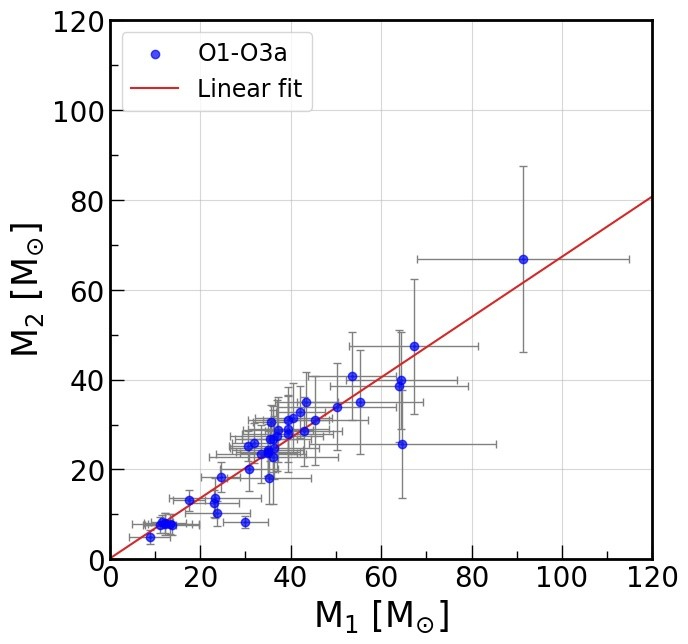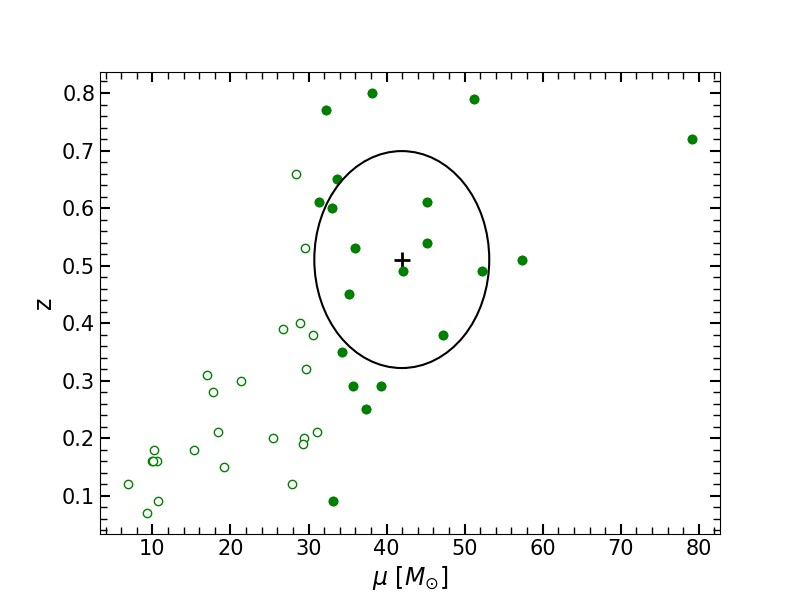SiteMap
close
Research
Research News
A prestigious global university that fosters Sejong-type talent who challenges creative thinking and communicates with the world.
|
ON THE PROGENITORS OF BBHs IN GWTC-2 2023.10.20 155 |
|
|---|---|
|
ON THE PROGENITORS OF BBHs IN GWTC-2 Department of Physics and Astronomy Maurice van Putten The seminal LIGO detection of the binary black hole (BBH) merger event GW150914 - awarded the Nobel Prize of Physics in 2017 - opened a new window to the Universe, rife with similar events including mergers of neutron stars with another neutron star or black hole. The updated gravitational-wave detection catalogue GWTC-2 of 2021 released by the gravitational-wave collaboration LIGO-Virgo contains more than 40 BBH mergers events revealing some novel statistical properties such as a relatively tight correlation between their binary masses and a redshift distribution in the late-time Universe (Figs. 1-2).
Figure 1. Overview of primary (M1) and secondary (M2) masses of BBHs in GWTC- 2. Grey crosses indicate uncertainties. A linear fit shows a slope 0.67 with a correlation coefficient r = 0.93 ± 0.06. These BBHs are believed to be remnants of massive star-formation. In 1955, Edwin E. Salpeter introduced the Initial Mass Function (IMF) of single stars, described by a power law with Saltpeter index of α_S=2.35. This relation has proven to be remarkably robust and continues to be a central theme in understanding star formation. In a paper to appear in The Astrophysical Journal, PhD candidate Hye-Jin Park of ANU, recent graduates Shin-Jeong Kim, Shinna Kim and Professor Maurice H.P.M. van Putten of Sejong University show that the power law index of the mean mass μ of binary stellar progenitors of BBHs satisfies α_S≲α_B^'≲2α_S in the limit of maximally correlated, respectively, uncorrelated masses. GWTC-2 shows a power law index of α_B ≃2α_S in the tail of μ ≳ 31M☉ the BBH mergers, indicating uncorrelated progenitor stellar masses. The rather tight correlation of BBH masses shown in Fig. 1 suggests a binary stellar evolution with considerable mass-transfer to relatively similar masses, before the onset of two supernovae producing the observed BBHs (without disrupting the binaries). On a ΛCDM cosmology, the power law index α_B' of the progenitor stellar binary systems increases with cosmological redshift. Yet, the observed relation α_B≃2α_S effectively prohibits α_B'>α_B. The merger time of BBHs is hereby limited to time-scales relatively short compared to a Hubble time, i.e., the redshift distribution of their stellar progenitors is relatively close to that of the BBH mergers observed (Fig. 2). This puts BBH progenitors in late-time cosmology, at relatively recent times past the peak in the cosmic star-formation rate (i.e., z < 2), rather than the early epoch of Pop III stars.
Figure 2. Redshifts (circles) versus mean mass μ of the BBH with elements in the tail highlighted (filled). Mean values of mean mass and redshift in the tail (+) is indicated with 1σ uncertainty (ellipse). Upcoming LIGO-Virgo-KAGRA observational runs O4-5 planned for March 2023 may solidify our conclusions with an enlarged data-base of BBH mergers. These upcoming observations may provide a survey of the Local Universe including double neutron star mergers and their post-merger evolution, perhaps including energetic core-collapse supernovae associated with long gamma-ray bursts. Additional Reading GWTC-2 catalog: https://www.ligo.org/science/Publication-O3aCatalog/index.php Hye-Jin Park, Shin-Jeong Kim, Shinna Kim & Maurice H.P.M. van Putten, 2022, ApJ, 938, 69, https://doi.org/10.3847/1538-4357/ac9300 |
|
| Next | Direct evidence for modified gravity at low acceleration is reinforced by a new study of wide binary stars |
| Previous | Development and Utilization of Rice Varieties in Response to Climate Change |

